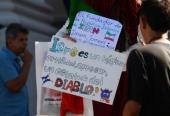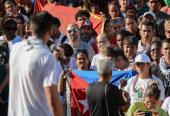Casineando for a World Record

Regardless what time may be, right now, somewhere on this Island or in any other geography, it’s very likely that at least a couple of Cubans are dancing casino.
It’s not by chance that Cuba intends to establish a new world record for popular sports and dances by simultaneously displaying the largest number of casino wheels and the largest number of dancers.
According to statistics provided by the National Council of Houses of Culture and INDER, nearly 5,000 Cubans of very different ages and occupations have taken part in this effort, the culmination of which will take place on May 5, in greeting to the upcoming Cuban Son Music Day, and its core will be the capital at La Piragua, although the event is multiplied in other places in the country.
This was reported on Sunday news by the vice president of the National Council of Houses of Culture, Irisday Ramírez del Monte, who assured that preparations began nine months ago and a minimum of 105 casino wheels are expected in optimal conditions to evolve following a tutorial from 8 minutes and 46 seconds.
La Piragua will host more than 1,500 dancers in this great challenge, which has the support of leaders of the international project Retomando el Son dancing casino, as well as dance instructors from the Houses of Culture and others who have also joined the organizational enthusiasm of the mega-wheels and choreography.
Our daily casino
The casino is almost part of the DNA of a good part of Cubans.
According to the Doctor in Art Sciences Bárbara Balbuena Gutiérrez, also a teacher and dancer, https://cubaescena.cult.cu/el-casino-y-el-fenomeno-mundial-de-la-salsa “the Casino acquires its name from one of the spaces with the greatest influence of dancing audiences in the late 1950s: the Club Casino Deportivo de La Habana, today “Círculo Social Obrero Cristino Naranjo” in the Playa municipality.
“Here, as in all places dedicated to social dancing, there’s a round dance floor that encouraged the use of circular design in the process of spontaneous and improvised dance creation, as a form of competitive game between couples to have fun. After acquiring a taste for the dance the casino owners, spread the word around to the rest of yacht clubs on the Havana coast that “let's dance in a wheel like in the Casino”, finally becoming the “Casino Wheel” or just Casino.
It was born spontaneously and collectively, therefore, its founding father is the people, whose steps in creating this genre were based on the Cuban ballroom dances that preceded it since the 19th century, but, according to Dr. Balbuena, the urban son music of Havana and chachachá were its main references.
The specialist, in an article published by Cubaescena, of the National Council of the Performing Arts https://cubaescena.cult.cu/el-casino-y-el-fenomeno-mundial-de-la-salsa , points out that Casino “ It has been baptized and globally recognized as the style of 'Cuban salsa dance' that has palpable differences with the linear one, especially because unlike the rest of modalities of line salsa dance, it’s performed in circular spatial designs."
In contrast to the so-called salsa at a global level, Casino has accompanied all types of genres, intergenres, modalities and diverse musical forms that have been fashionable in the country, from the late 50s to the present, including many that are not of national creation, indicates the scholar.
At present, the casino is in perfect health. Even though cultural globalization with its push is blurring identities and traditions, the beauty, vitality, as well as the dialogue of bodies and emotions that distinguish the Casino have meant that it’s not relegated.
Wherever music is heard, the kind that goes directly to where it resonates most, there will always be - whether in a nightclub, at a square or at a party - those whose soul begins to move first and then their feet, to start in the basic steps and spin dancing Casino, which is to continue drawing identity, culture, roots.
Translated by Amilkal Labañino / CubaSí Translation Staff














Add new comment